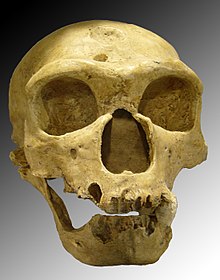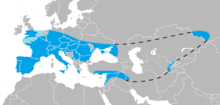Neanderthal
| Neanderthal Temporal range:Pleistocene
| |
|---|---|

| |
| H. neanderthalensis,La Chapelle-aux-Saints | |

| |
| Mounted Neanderthal skeleton,American Museum of Natural History | |
| Ipò ìdasí | |
| Ìṣètò onísáyẹ́nsì | |
| Ìjọba: | |
| Ará: | |
| Ẹgbẹ́: | |
| Ìtò: | |
| Ìdílé: | |
| Ìbátan: | |
| Irú: | H. neanderthalensis
|
| Ìfúnlórúkọ méjì | |
| Homo neanderthalensis King,1864
| |

| |
| Range ofHomo neanderthalensis.Eastern and northern ranges may be extended to include Okladnikov inAltaiand Mamotnaia inUral | |
| Synonyms | |
|
Palaeoanthropus neanderthalensis | |
Neanderthal(pípè/niːˈændərtɑːl/,/niːˈændərθɔːl/), tabi/neɪˈændərtɑːl/),[1]bakanna kiko biNeandertal,[2]ni ikan ninu iranHomoto ti pare to wa nigbaPleistocenespecimensni Europe ati apaiwoorun atiarin Asia.Neanderthals je titopo boya bisubspecies(tabieya) awoneniyan(Homo sapiens neanderthalensis) tabi biiru edaotooto (Homo neanderthalensis).[3] AwontraitsNeanderthal-asiwaju akoko yo wa ni Europe ni bi odun 600,000–350,000 seyin.[4]Loni (ni 2010)ifihan genetikidabaibimopaposele peluHomo sapiensni bi odun 80,000 to 50,000 seyin, won si ni gbagbo pe awon eniyan isun Eurasia je bi 1% de 4% Neanderthal.

|
Àyọkà yìí tàbí apá rẹ̀ únfẹ́ àtúnṣe sí. Ẹ lefẹ̀ jù báyìí lọtàbí kí ẹṣàtúnṣerẹ̀ lọ́nà tí yíò mu kúnrẹ́rẹ́. Ẹ ran Wikipedia lọ́wọ́ látifẹ̀ẹ́ jù báyìí lọ. |
Itokasi[àtúnṣe|àtúnṣe àmìọ̀rọ̀]
- ↑The pronunciation/niːˈændərθɔːl/is very common in the United States and is often listed first in US dictionaries, for exampleAmerican Heritage Dictionary and Random House Dictionaries.The UK pronunciation is/niːˈændərtɑːl/,as shown inCambridge Advanced Learner's Dictionary)[Ìjápọ̀ tí kò ṣiṣẹ́ mọ́],andOxford Advanced Learner's Dictionary.
- ↑Neandertalis a widespread alternative spelling in English (see also US dictionaries in previous footnote) becoming so common that it is sometimes now listed first in dictionaries, for exampleMSN EncartaArchived2009-12-26 at theWayback Machine.. 2009-11-01.
- ↑Tattersall I, Schwartz JH (June 1999)."Hominids and hybrids: the place of Neanderthals in human evolution".Proceedings of the National Academy of Sciences96(13): 7117–9.doi:10.1073/pnas.96.13.7117.PMC33580.PMID10377375.http://www.pnas.org/cgi/pmidlookup?view=long&pmid=10377375.Retrieved 17 May 2009.
- ↑J. L. Bischoff et al. (2003). "The Sima de los Huesos Hominids Date to Beyond U/Th Equilibrium (>350 kyr) and Perhaps to 400–500 kyr: New Radiometric Dates".J. Archaeol. Sci.30(30): 275.doi:10.1006/jasc.2002.0834.
تلارملامتالاك نلاات
هت ه خت تت ت ت ت ت ت تت ةنتن
- All articles with dead external links
- Articles with dead external links from September 2023
- Articles with invalid date parameter in template
- Articles with permanently dead external links
- Webarchive template wayback links
- IUCN Red List extinct species
- Taxoboxes with the error color
- Taxobox articles missing a taxonbar
- Àwọn ọmọnìyàn

